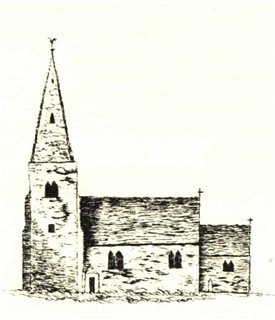Flawforth

Flawford/Flawforth church "sketched from memory by a Mr Carver who was born at Ruddington
From Throsby's Antiquities of Nottinghamshire, 1790-6, Vol I
Lost Village
Located 1 mile east of Ruddington.
More commonly known today as Flawford, the name Flawforth was also used historically. Thoroton (1) writing in 1677 refers to the settlement as Flawforth, whilst Throsby (2), updating and extending his work records it as Flawford.
To a certain extent the two names co-exist even to this day with Flawford House and Flawforth Lane
A Lost Village or just a Lost Church?
Any status as a 'Lost Village' is largely as a result of the documented removal of its church in the 18th century (see below), and the suggestion that, around the church, the site once also possessed a number of houses.
Everard Guilford, writing in 1910 (1), is certainly one writer who refers to Flawforth as Lost village:-
"Nothing remains of the village", he says, "which occupied the top of a slight hill. That the place was of some importance is witnessed by the fact that the church was the mother church of the chapelries of Ruddington and Edwalton".
Throsby (3) too makes reference to there having once been a village on the site: he says that leave was given to demolish the Flawford/Flawforth church in 1773 because it was in a very ruinous state and because "not a dwelling of the village remain[ed]" (our italics).
Again, a newspaper report (quoted by Throsby (2)) - from "the Nottingham paper" - at the time of the church's demolition refers to "the cottagers of the village have amused themselves, to the number of 30 or 40 at a time, with drawing wagons loaded with stone, containing near three tons, from the spot where the fabric stood, to a brook near two miles distant.... for the purpose of building a bridge...." (italics added).
The Lost Church of Flawforth/Flawford - Demolished by Colliers
The original church was Saxon, being largely replaced by a medieval structure in the 13th and 14th centuries.
The position of the church meant that it was on a crossroads and virtually equidistant from the villages of Ruddington, Plumtree, Edwalton and Bradmore. The fact that Flawford church was built in this location suggests that it was the earliest of the local churches, pre-dating those later established in the four surrounding villages. (There is only documentary evidence, however, to show that it served as the mother church for Ruddington and Edwalton.
Writing of the church at Flawford/Flawforth, Guilford (3) says "Various descriptions of the building remain, which show it to have been of considerable size. It was not used after 1718, and was pulled down in 1773". In fact parts of the church were demolished separately at different times - the nave in 1773 and the chancel in 1778 - with the graveyard continuing in commission till at least 1787.
The last person to be interred in Flawford churchyard (says Throsby (2) p.130) was a John Wilkinson, aged 80
Interestingly, the date of 1773 for the demolition of the churchis nicely recorded by Throsby (2) where he says "In an old memorandum book, shewn me by the clerk of Ruddington, which was kept by an old schoolmaster, is the entry 'Saturday June 12th, 1773, Flawford Church was demolished by colliers"
About three years previously (ie c.1770) continues Throsby, "18 of 20ft of the spire fell, which in some measure hastened its final dissolution". Stone from the tower, he says, was used to mend roads, make pigsties and horse blocks, whilst gravestones from Flawford were seen to be lying in some Ruddington farmyards
Today, the site of the church is preserved as open ground with the outline of the church depicted in stones.
REFERENCES
(1) THOROTON, Robert The Antiquities of Nottinghamshire (1677)
(2) THROSBY, John The Antiquities of Nottinghamshire, edited and enlarged by John Throsby (1790-96) Vol.1 p.129
(3) GUILFORD, Everard L. Nottinghamshire (London: Methuen & Co., 1910) p.88